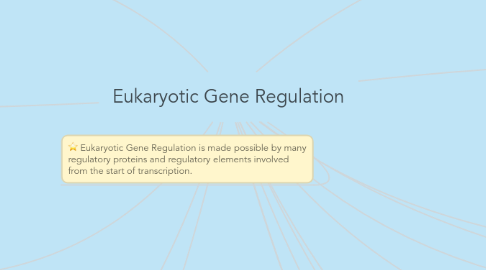Eukaryotic Gene Regulation
Lara Uthmanにより

1. Eukaryotic Gene Regulation is made possible by many regulatory proteins and regulatory elements involved from the start of transcription.
2. Modification of DNA
2.1. Addition of Acetyl Groups- This loosens chromatin, and increases transcription
2.2. Methylation- This prevents/decreases transcription
3. Transcriptional
3.1. Control Elements- Addition of segments of noncoding DNA can start/stop transcription (attach upstream from the promoter)
4. Post-Transcriptional
4.1. Alternate mRNA processing- taking out different introns and leaving different genes
4.2. mRNA degradation- destroying mRNA & RNAi
4.2.1. mIRNA- micro RNA, regulates genes: less specific
4.2.2. siRNA- small interference RNA: targets a specific code
5. Translational
5.1. Addition of Poly-A tails before an egg gets fertilized
6. Protein Degradation
6.1. Ubiquitin- when you tag a protein with Ub, the protesome breaks down
7. https://www.ck12.org/biology/eukaryotic-gene-regulation/lesson/Eukaryotic-Gene-Regulation-BIO/?referrer=new_concept_map
8. These genes produce regulatory proteins that control the cell cycle.
9. Proto-oncogenes
10. Tumor-Supressor Genes
11. CANCER: The mutations that cause cancer typically occur in two types of regulatory genes.
12. Homebox Genes:regulate development
13. Hox Genes: Ensure that body parts such as limbs develop in the correct place.
14. DEVELOPMENT: The regulation of gene expression in eukaryotes is extremely important for development. Regulatory proteins must turn on certain genes in particular cells.
15. TATA BOX: The TATA box is a regulatory element that is part of the promoter of most eukaryotic genes. Multiple regulatory proteins bind to the TATA box, forming a multi-protein complex. This is a crucial step that starts transcription.
16. Negative
16.1. Operons are switched off by the active form of the repressor protein
16.2. Allolactase includes enzyme synthesis when lactose is present, the operons are switched on when the repressor protein is inactive
16.3. When the repressor protein is active, tryptophan is not made because the operon is switched off
17. Positive
17.1. Some operons are also subject to positive control through assimilatory protein like CAP, an activator of transcription
17.2. Gene regulation is positive when a regulatory protein interacts directly with the DNA to switch transcription on


